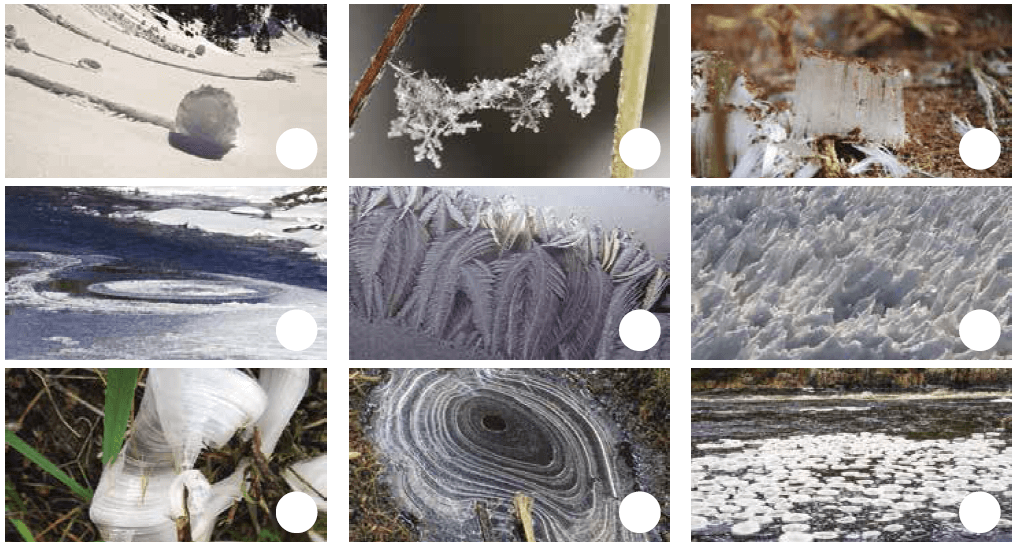Frozen water can take some pretty incredible forms! Learn about a few of them here, and then go out and see if you can find any of these amazing formations yourself. Perhaps you’ll even find some fantastic formations that aren’t on this list. Happy icy investigations!

Pancake Ice
Pancake ice is—you guessed it!—round, and forms when ice on a stream or river breaks up and gets spun around in an eddy, creating ice circles that can be anywhere from a foot to ten feet in diameter. Pancake ice forms when there is still some water movement and the temperature hovers around freezing. Often the individual “pancakes” will bump into each other, creating a raised band of slush around the edges, resulting in “pancakes” with high edges and low centers.
Snow Rollers
This fascinating and rare phenomenon occurs when temperatures are near freezing and a thin layer of wet snow lies on top a layer of ice or powder snow. The final piece is force: wind or gravity, which causes the snow to roll along the ground, gathering layers as it goes. Snow rollers are usually cylindrical and look very much like hay bales—in fact, they are also called “snow bales” or “snow donuts.”
Ice Discs
Another rare phenomenon, ice discs form in the bends of slow-flowing rivers, where the current breaks off a piece of ice as it forms on the surface, then rotates it, grinding it against the surrounding ice until it smooths into a circle. The ice disc remains in the bend of the river, rotating slowly. Ice discs can be quite large—as much as 50 feet across.
Snowflakes
Snowflakes form when water vapor turns directly into ice—condensing on a tiny particle of dust or pollen in the air—and skipping the liquid stage. They are six-sided, and, when the temperature is right, form lovely complex patterns as more water vapor condenses onto the original snow crystal as it falls through the air.
Ice Ribbons
The unusual appearance of this striking formation has inspired a variety of different names, including “ice wool,” “rabbit ice,” and “ice flowers.” Ice ribbons form when the ground is not yet frozen but the air temperature drops below freezing, causing the sap in the plant to freeze and crack the plant’s stem. Water is drawn out of these cracks through capillary action, turning to ice as it hits the air and creating layer after layer of thin “ribbons.”
Window Frost
When the outside temperatures are below freezing and the inside air is humid, the moisture in the air can condense as ice crystals on the inside of a window pane. Often forming intricate shapes, the spreading crystal structures can look like feathers, ferns, flowers, and more. Take a closer look. What do you see?
Penitentes
Named for their resemblance to crowds of people kneeling in penance, these “penitent-shaped snows” are found at high altitudes, occurring when the air is very dry and the dew point is below freezing. This combination causes the snow to go directly from a solid to a gas without turning to liquid in between, resulting in a melting pattern that creates a series of jagged, steep-sided snow structures that lean in the general direction of the sun.
Ice Castles
Like ice ribbons, ice castles occur when the air temperature drops below freezing while the temperature of the soil remains above freezing. Water in the soil is drawn to the surface and freezes once it comes into contact with the air, forming delicate columns. Other names include “ice fringes,” “frost columns,” and “needle ice.”
Cat Ice
This ice formation is more common, and most of us have probably seen it—it’s the very thin, brittle ice that forms in puddles and other small bodies of water. When the water beneath recedes and refreezes, it creates a series of concentric circles, and is called “cat” ice because it’s theoretically able to hold the weight of a light-footed cat. Being heavier, humans of all ages have fun walking on and breaking this ice!
Answers to quiz, left to right each row:
Snow Rollers, Snowflakes, Ice Castles
Ice Discs, Window Frost, Penitentes
Ice Ribbons, Cat Ice, Pancake Ice
This article was originally published in the Winter 2018-2019 issue of Montana Naturalist magazine, and may not be reproduced in part or in whole without the written consent of the Montana Natural History Center. ©2018 The Montana Natural History Center.
Click here to read more articles from Montana Naturalist magazine.
Want to learn more about our programs? Sign up for our e-newsletter! You can also become a member and get discounts on our programs as well as free reciprocal admission to 300+ science centers in North America!












